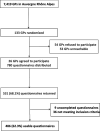Screen exposure time of children under 6 years old: a French cross-sectional survey in general practices in the Auvergne-Rhône-Alpes region
- PMID: 36859171
- PMCID: PMC9975848
- DOI: 10.1186/s12875-023-02009-5
Screen exposure time of children under 6 years old: a French cross-sectional survey in general practices in the Auvergne-Rhône-Alpes region
Abstract
Background: The advent of miniature, easy-to-use and accessible multimedia products is leading to screen exposure that begins in early childhood. Overexposure in preschool may lead to adverse effects. The main objective of this study was to determine the average daily time (ADT) spent by children under 6 years of age, followed in general practice, in front of television or interactive screens.
Methods: A cross-sectional survey was conducted in the Auvergne-Rhône-Alpes region among randomly selected General Practitioners (GPs). The average daily screen time (ADST), regardless of the type of device (TVs, computers, tablets, smartphones, video game consoles), of the included children aged 0 to 2 years and 2 to 5 years was calculated from a self-questionnaire completed by the parents. A multivariate Poisson regression model was performed to analyse daily screen time, adjusted by factors selected on their clinical relevance and statistical significance.
Results: The 26 participating GPs included 486 parents. They reported an ADST of 26 (± 44) minutes on weekdays and 30 (± 46) minutes on weekends for children under 2 years of age. For children over 2 years of age, the ADST was 66 (± 82) minutes on weekdays and 103 (±91) minutes on weekends. There was an association between the children's average screen time and certain sociodemographic and environmental factors. Children whose parents had higher levels of education, those living in a family without TV screens or those who were well informed about the possible adverse health consequences of overuse of screens had lower average screen time. On the other hand, children of parents who spent more than 2 hours a day in front of screens, were more exposed.
Conclusions: In our survey, the ADST of children under 6 years of age followed in general practice was higher than the current recommendations. GPs can warn parents of preschool children of the effects of overexposure to screens, particularly parents of at-risk children.
Keywords: Children; Cross-sectional survey; Digital media; General practice; Screen time; Television.
© 2023. The Author(s).
Conflict of interest statement
The authors declare no competing interests.
Figures




Similar articles
-
[Family habits related to the excessive use of recreational screens (television and video games) in childhood.].Rev Esp Salud Publica. 2021 Jan 14;95:e202101002. Rev Esp Salud Publica. 2021. PMID: 33443495 Spanish.
-
The mediating role of the home environment in relation to parental educational level and preschool children's screen time: a cross-sectional study.BMC Public Health. 2017 Sep 2;17(1):688. doi: 10.1186/s12889-017-4694-9. BMC Public Health. 2017. PMID: 28865436 Free PMC article.
-
Parents' Knowledge On, Attitude Toward, and Practice of Screen Time Exposure Regulation of Their Children Under Six Years of Age in Western Region, Saudi Arabia.Cureus. 2023 Nov 26;15(11):e49464. doi: 10.7759/cureus.49464. eCollection 2023 Nov. Cureus. 2023. PMID: 38152829 Free PMC article.
-
The Relationship between Language and Technology: How Screen Time Affects Language Development in Early Life-A Systematic Review.Brain Sci. 2023 Dec 25;14(1):27. doi: 10.3390/brainsci14010027. Brain Sci. 2023. PMID: 38248242 Free PMC article. Review.
-
Screen time and preschool children: Promoting health and development in a digital world.Paediatr Child Health. 2023 May 16;28(3):184-202. doi: 10.1093/pch/pxac125. eCollection 2023 Jun. Paediatr Child Health. 2023. PMID: 37205134 Free PMC article. Review.
Cited by
-
Problematic Digital Technology Use Measures in Children Aged 0 to 6 Years: Scoping Review.JMIR Ment Health. 2025 Mar 18;12:e59869. doi: 10.2196/59869. JMIR Ment Health. 2025. PMID: 40100254 Free PMC article.
-
Unravelling the Enigma: How Behavioural Addictions Alter the Developing Child Brain?Ann Neurosci. 2023 Jul;30(3):149-150. doi: 10.1177/09727531231197513. Epub 2023 Sep 8. Ann Neurosci. 2023. PMID: 37779549 Free PMC article. No abstract available.
-
Digital Devices Use and Fine Motor Skills in Children between 3-6 Years.Children (Basel). 2023 May 28;10(6):960. doi: 10.3390/children10060960. Children (Basel). 2023. PMID: 37371192 Free PMC article.
-
The Impact of Screen Time on Sleep Patterns in School-Aged Children: A Cross-Sectional Analysis.Cureus. 2024 Feb 29;16(2):e55229. doi: 10.7759/cureus.55229. eCollection 2024 Feb. Cureus. 2024. PMID: 38425328 Free PMC article.
-
The Impact of Modifiable Parenting Factors on the Screen Use of Children Five Years or Younger: A Systematic Review.Clin Child Fam Psychol Rev. 2025 Jun;28(2):458-490. doi: 10.1007/s10567-025-00523-9. Epub 2025 May 1. Clin Child Fam Psychol Rev. 2025. PMID: 40310597 Free PMC article. Review.
References
-
- Rideout VJ, Robb MB. The common sense census: media use by kids age zero to eight. 2020.
-
- Gassama M, Bernard J, Dargent-Molina P, Charles M-A. Activités physiques et usage des écrans à l’âge de 2 ans chez les enfants de la cohorte Elfe. 2018.
MeSH terms
LinkOut - more resources
Full Text Sources
